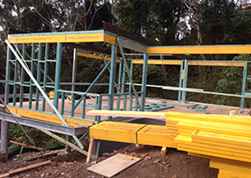
Blue pine and yellow laminated veneer lumber
Many factors affect how well timber treatments work, including
- what chemical or mixture of chemicals is used
- the concentration of chemicals
- which part of the timber is being treated
- how the treatment is applied
- how long the chemicals stay in the wood
The harsher the environment where the final product will be used, the deeper, longer lasting and stronger the treatment needs to be. Generally, the stronger the treatment, the more hazardous to human health the chemicals used to treat the timber are.
Treated timber types
The timber treatments below are listed according to their hazard levels, with treatments with low hazard levels being listed nearer the top of the list.
- Boron-based treated timber
- Blue pine
- Timber treated with light organic solvent preservative (LOSP)
- Copper based alternatives to CCA
- Creosote
- Copper chrome arsenate (CCA)
How timber treatments are applied
Preservatives are applied to timber in several ways, including
- envelope-treatment where the treatment surrounds the timber rather than soaking into it
- dipping and spraying
- as an additive to glue for laminated veneer lumber (LVL) products
- vacuum pressure impregnation (VPI) where treatments are forced into the timber.
VPI involves placing a stack of timber inside an air-proof cylinder and applying a vacuum to remove as much water as possible. Treatment chemicals are then pumped in under pressure until they reach the required level. A final vacuum extracts any remaining preservative.
More information is available from the Treated Timber Preservers Association of Australia (TPAA).

